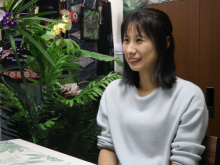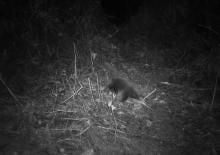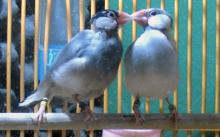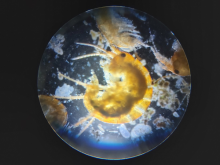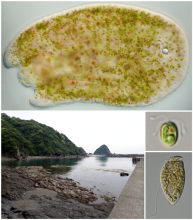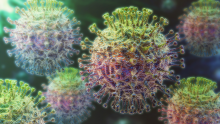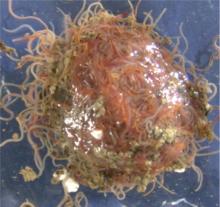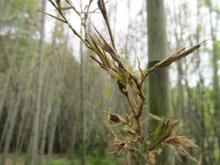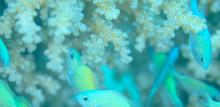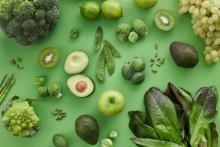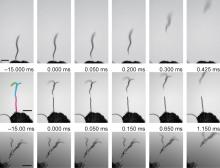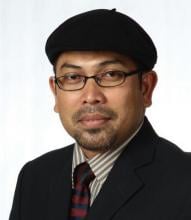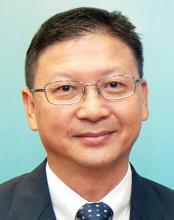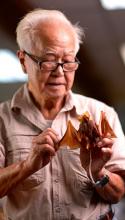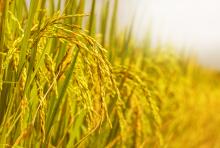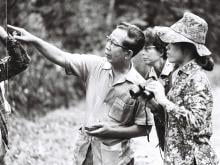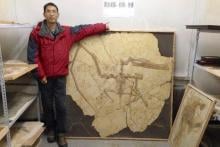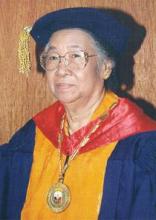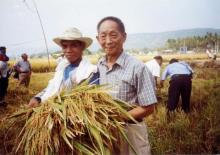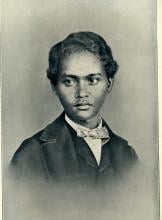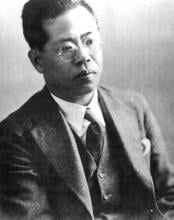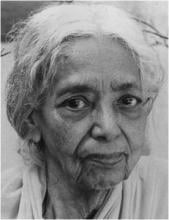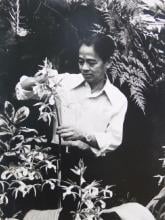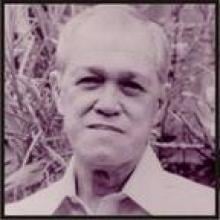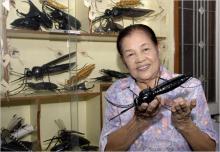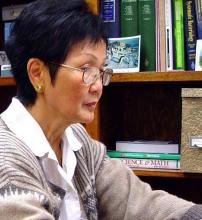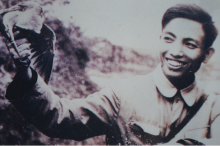Plants & Animals
News
13 Dec 2023
Scientists at Osaka Metropolitan University have developed an efficient, non-invasive, and pain-free method to generate canine-induced pluripotent stem cells (iPSCs). They identified six reprogramming genes that can boost canine iPSC generation by 120 times compared to conventional methods using fibroblasts. The iPSCs were created from urine-derived cells without the need for feeder cells, an impossible feat until now. Their findings are expected to advance regenerative medicine and genetic disease research in veterinary medicine.
08 Dec 2023
Asia Research News monitors the latest research news in Asia. Some highlights that caught our attention this week are how eels can transfer DNA, older babies falling for tricks that younger ones do not, and a crystal layer deep in the Earth.
01 Dec 2023
Asia Research News monitors the latest research news in Asia. Some highlights that caught our attention this week are hungry, grumpy bears that don’t sleep, solving a 200-year-old mystery about dolomite, and how yoga can help people with epilepsy.
24 Nov 2023
Asia Research News monitors the latest research news in Asia. Some highlights that caught our attention this week are screentime changing children’s brains, a bacterium that can help reduce toilet time, and a reproductive strategy that is definitely not the butt of the joke.
21 Nov 2023
Out of this living laboratory emerged unexpected insights on coexistence from an “unusual” source.
17 Nov 2023
Asia Research News monitors the latest research news in Asia. Some highlights that caught our attention this week are sea cucumbers that glow in the dark, a needle that softens at body temperature, and the real size of our sun.
16 Nov 2023
The winners of the Applied Microbiology International Horizon Awards were announced at the prestigious Environmental Microbiology lecture 2023, held at BMA House in London on November 16.
10 Nov 2023
Asia Research News monitors the latest research news in Asia. Some highlights that caught our attention this week are how mice help disperse seeds of a centennial blooming plant, a new isle created by recent volcanic activity, and how organisms breaking up microplastics is not always a good thing.
10 Nov 2023
Expedition led by Indonesian NGO YAPPENDA with Cenderawasih University students finds two species lost to science: Attenborough’s long-beaked echidna—one of Re:wild’s most wanted lost species—and Mayr’s honeyeater.
09 Nov 2023
New shrimp species in ancient hot spring, Super sprouts, How "warm-ups" work, New antiviral candidate, Solving voltage decay and from our blog: A sustainable future shines in TIE 2023. Read all in the latest Editor's Choice.
27 Oct 2023
Asia Research News monitors the latest research news in Asia. Some highlights that caught our attention this week are parasites that borrow their hosts genes, how waste feathers can be used in hydrogen fuel cells, and a poor bird that was caught up in a powerful typhoon.
25 Oct 2023
Pair-bonded Java sparrows show enlarged eye rings to signal breeding readiness.
20 Oct 2023
Asia Research News monitors the latest research news in Asia. Some highlights that caught our attention this week are helping to speed up chronic wound healing by gently moving skin cells, distinct species of Japanese honeybees, and how the world’s smallest flowing plant can help astronauts.
13 Oct 2023
A new amphipod species thrives at record temperatures in nearby hot spring pools of an ancient Inca city, defying norms for these typically cold-dwelling animals. Unraveling its key adaptations can give clues for the survival of other freshwater creatures in our warming world.
06 Oct 2023
Asia Research News monitors the latest research news in Asia. Some highlights that caught our attention this week are the confirmation of a route that humans took to migrate from Africa, how pheromones can influence beetle behavior, and microplastics found in cloud water.
05 Oct 2023
Acoels have been found to host a wide diversity of symbiotic, photosynthetic microalgae.
15 Sep 2023
Asia Research News monitors the latest research news in Asia. Some highlights that caught our attention this week are a previously unrecorded species of ant found in someone’s backyard, comparing traditional medicine to drugs for indigestion, and how breastfeeding can help babies develop a healthy gut.
11 Sep 2023
Researchers have unveiled an intriguing phenomenon of cellular reprogramming in mature adult organs, shedding light on a novel mechanism of adaptive growth. The study, which was conducted on fruit flies (Drosophila), provides further insights into dedifferentiation - where specialized cells that have specific functions transform into less specialized, undifferentiated cells like stem cells.
08 Sep 2023
Asia Research News monitors the latest research news in Asia. Some highlights that caught our attention this week are a new species of fish that was spotted being sold at local markets, how humans almost went extinct, and an Earth-like planet that may be lurking in our solar system.
08 Sep 2023
Capturing carbon dioxide, Shells go nuclear, Worms surf electric fields, Brain repair & Creating matter from light. Plus from our blog: Monitoring research for further impact. Read all in the latest Editor's Choice.
08 Sep 2023
Study addresses gaps in understanding of swine influenza A virus evolution and highlights need for early warning of disease emergence
01 Sep 2023
Tubificine worms inhabit the sediments of lakes and rivers. They can form into blobs that behave like a single organism to adapt to extreme environmental conditions. Recreating an uneven and confined terrain, a group of scientists has recently studied the collective movement of worm blobs.
29 Aug 2023
A long-lived monocarpic species of bamboo, Phyllostachys nigra var. henonis, only flowers once every 120 years before it dies. The upcoming flowering event for this species does not bode well for its continued long-term survival, as most flowers are not producing viable seeds.
25 Aug 2023
Asia Research News monitors the latest research news in Asia. Some highlights that caught our attention this week are how melatonin can help us remember objects, drones that can assemble and disassemble in mid-air, and a new species of anemone.
23 Aug 2023
Researchers have identified a new pathway by which sugar is released by symbiotic algae. This pathway involves the largely overlooked cell wall, showing that this structure not only protects the cell but plays an important role in symbiosis and carbon circulation in the ocean.
23 Aug 2023
Associate Professor Taweechai Amornsakchai and his team of international researchers have developed novel bio-degradable rigid foams derived from pineapple waste, showcasing impressive properties. Starch and cellulosic materials are key components of the foams, which are processed via microwave gel formation and filler blending. The foams feature high strength, and rapid biodegradation, with potential for practical use from packaging, to construction, automotive, and aerospace.
17 Aug 2023
Japanese fossil forest found, AI finds a way to people’s hearts, Language diversity and child social development & Supplement for kidney disease. Plus Submissions open for Asia Research News 2024. Read all in the latest Editor's Choice.
11 Aug 2023
A team of scientists from Thailand and Malaysia, led by principal investigator, Associate Professor Taweechai Amornsakchai from Mahidol University, has successfully developed a low-cost and green method to make films prepared from pineapple stem starch for food packaging, such as fruits and vegetable.
11 Aug 2023
Asia Research News monitors the latest research news in Asia. Some highlights that caught our attention this week are particle pollution linked to antibiotic resistance and microplastics being found in the body, fossils that show a marine reptile that used filter feeding, and how a connection in our brains compares our rewards to ones that others received.
10 Aug 2023
Hokkaido University researchers found that tiny nematode worm larvae surf electric fields to hitch rides on passing insects.
Events
Sorry, no events coming up for this topic.
Researchers
International Islamic University Malaysia (IIUM)
Professor at Department of Landscape Architecture, KAED, International Islamic University Malaysia (IIUM), Kuala Lumpur, Malaysia. Research interests include urban design/urban landscape, cultural landscape, residential landscape, GIS and human-computer interaction, and environmental planning.
Nagoya University
Michitaka Notaguchi is an assistant professor at the Bioscience and Biotechnology Center, Nagoya University, Japan.
Universiti Putra Malaysia (UPM)
Currently Associate Professor at Universiti Putra Malaysia. Holds a PhD from University College of Wales and BSc (Hons) Genetics from the University of Liverpool
Professor and Head of Microbiology and Immunology Department,
Faculty of Medicine, Lincoln University College (LUC) Malaysia.
Hong Kong Baptist University (HKBU)
Professor Qiu Jianwen currently works at the Department of Biology, Hong Kong Baptist University. He is interested in ecology and adaptation of apple snails, biodiversity and systematics of polychaetes, stress responses in shallow-water corals, and deep-sea biology. His research involves the use of various molecular tools including transcriptomics, proteomics and genomics.
Universiti Malaysia Sarawak
Mohd Zacaery Khalik is a lecturer at the Universiti Malaysia Sarawak and is pursuing his Ph.D with the Naturalis Biodiversity Center and Leiden University in The Netherlands. He researches the evolution of snails in Borneo.
Professor in Agriculture and Education in the Iloilo Science and Technology University Leon Campus (ISAT U). Leon, ILOILO, PHILIPPINES
Giants in history
Pakistani botanist Azra Quraishi (22 September 1945 – 22 November 2002) is recognised for developing virus-free seed potatoes that increased potato production in Pakistan by an estimated five per cent.
Sálim Moizuddin Abdul Ali (12 November 1896 – 20 June 1987), commonly referred to as the Birdman of India, was the first person to conduct systematic surveys of birds from across India.
Indian botanist Shipra Guha-Mukherjee (13 July 1938 – 15 September 2007) made a breakthrough discovery that enabled the genetic study of plants and, by extension, the development of improved varieties of rice, wheat, potatoes, and other crops.
During her short life, Fahire Battalgil (1902 - 1948) achieved renown as the first zoologist from Turkey to make strides in the field of freshwater fish biodiversity.
Lim Boo Liat (21 August 1926 – 11 July 2020), a leading authority in the conservation of Malaysia’s biological diversity, had his initial interest in the outdoors piqued by nature lessons in school. Lim, who helped found the National Zoo of Malaysia and re-establish the Malaysian Nature Society, had a particular interest in researching zoonotic diseases associated with small animals.
In his over 30 year career in rice research, Munshi Siddique Ahmad (1924 – 19 October 2011) developed more than 30 varieties of high-yielding rice, including the BRRI Shail strain, which was responsible for increasing the rice production of Bangladesh from 8 million tonnes in 1965 to 20 million tonnes in 1975.
Known as Mr. Natural Rubber, chemist and researcher B. C. Shekhar (17 November 1929 – 6 September 2006) introduced a number of technical innovations that helped put Malaysia’s natural rubber industry on the world map.
Ground-breaking cancer researcher Kamal Jayasing Ranadive (8 November 1917 – 11 April 2001) advanced the understanding of the causes of leukaemia, breast cancer and oesophageal cancer through the use of animal models. She was also among the first to recognise how susceptibility to cancer is linked to tumour-causing interactions between hormones and viruses.
Birbal Sahni (14 November 1891 – 10 April 1949), a pioneer of Indian palaeobotanical research, and founder of what is now the Birbal Sahni Institute of Palaeosciences in Lucknow, made multiple contributions to the study of prehistoric plants. These include the discovery of a new group of fossil gymnosperms (named Pentoxylae), reconstruction of the extinct Williamsonia sewardiana plant, and description of a new type of petrified wood from the Jurassic age.
The research of Filipino pharmaceutical chemist Luz Oliveros-Belardo (3 November 1906 – 12 December 1999) focussed on essential oils and other chemicals derived from native Philippine plants.
Thai physician and conservationist Boonsong Lekagul (1907 – 1992) made major contributions to the preservation of his country’s wildlife.
Lü Junchang (1965–9 October 2018) was a Chinese palaeontologist who is remembered as one of the most important dinosaur researchers of the last 50 years. Lü was an expert on reptiles that lived during the Mesozoic period about 252 million years ago. Cumulatively, Lü and his colleague/competitor Xiaolin Wang described and named more than 50 new species of flying dinosaurs known as pterosaurs.
Filipina chemist María Orosa (29 November 1892–13 February 1945) fought malnutrition and food insecurity in the Philippines by devising over 700 culinary creations including Soyalac, a nutrient rich drink made from soybeans, and Darak, rice cookies packed with Vitamin B1, which could prevent beriberi disease caused by Vitamin B1 deficiency. She was also a partisan of the guerrilla movement resisting Japanese occupation during World War II, and died after being struck by shrapnel while working in her laboratory during the Battle of Manila.
Eminent Filipina scientist and educator Clara Lim-Sylianco (18 August 1925 – 23 July 2013) is remembered for her extensive research on mutagens – often-carcinogenic agents that permanently alter genetic materials such as DNA – antimutagens and bioorganic mechanisms.
Research by Filipino plant scientist Benito Vergara (23 June 1934 – 24 October 2015) on the physiology of rice led to the development of deep-water and cold-tolerant rice varieties. Vergara also made several contributions to expanding public awareness of rice science.
Chinese palaeontologist, archaeologist and anthropologist Pei Wenzhong (January 19, 1904 – September 18, 1982) is regarded as a founder of Chinese anthropology.
Chinese agronomist Yuan Longping (7 September 1930 – 22 May 2021) developed the first varieties of the high-yield, hybrid rice that brought food security to multiple countries including China, which had been ravaged by food shortages as recently as the mid-20th century.
Little is known about Ali, a teenager from Sarawak, Malaysia, who was chief assistant to the famous naturalist Alfred Wallace. Most of what is known comes from Wallace’s writings. Ali accompanied Wallace on expeditions throughout the Malay Archipelago from December 1855 to February 1862.
The techniques that make industrial pearl culturing possible were developed over a century ago at the Misaki Marine Biological Station in Japan. The station’s first director, Professor Kakichi Mitsukuri, emphasized to Kokichi Mikimoto in 1890 that stimulating pearl sac formation was important for pearl growth, and they went on to successfully develop methods for culturing pearls.
Indian organic chemist Asima Chatterjee (1917 to 2006) studied the medicinal properties of plant products, especially compounds known as vinca alkaloids.
Motoo Kimura (13 November 1924 – 13 November 1994) was a Japanese theoretical population geneticist who is best remembered for developing the neutral theory of molecular evolution.
Sir Jagadish Chandra Bose (30 November 1858 – 23 November 1937) was a scientist and inventor who contributed to a wide range of scientific fields such as physics, botany and biology.
Rinchen Barsbold (born 21 December 1935) is a Mongolian palaeontologist and geologist who was instrumental in discovering and recovering one of the largest dinosaur collections in the world from the Gobi Desert in Mongolia and China.
Osamu Shimomura (27 August 1928 – 19 October 2018) was a Japanese organic chemist and marine biologist who dedicated his career to understanding how organisms emitted light.
Woo Jang-choon (8 April 1898 – 10 August 1959) was a Korean-Japanese agricultural scientist and botanist.
Joo-myung Seok (November 13, 1908 – October 6, 1950) was a Korean butterfly entomologist who made important contributions to the taxonomy of the native butterfly species in Korea.
Janaki Ammal Edavalath Kakkat (4 November 1897 – 7 February 1984) was an Indian botanist who studied plant chromosomes and genetics.
Salimuzzaman Siddiqui (19 October 1897 – 14 April 1994) was an artist and chemist from Pakistan whose research focused on natural products from plants.
Rapee Sagarik (4 December 1922 – 17 February 2018) was Thailand’s renowned expert on orchids.
Maqsudul Alam (14 December 1954 – 20 December 2014) was a biologist from Bangladesh who is renowned for his research on genome sequencing
Susan Lim (14 February 1952 – 2 August 2014) was a Malaysian parasitologist who specialized in studying a class of flatworms, the Monogeans, which are parasites of fishes.
Kono Yasui (16 February 1880 – 24 March 1971) was a Japanese botanist who researched the genetics of poppies, corn and spiderworts and surveyed the plants that had been affected by the nuclear fallout after the atomic bombings of Hiroshima and Nagasaki.
Julian Arca Banzon (13 March 1908 – 13 September 1988) was a biochemist from the Philippines who was a pioneer in alternative fuel research. Banzon investigated the use of indigenous crops as sources of renewable fuels and chemicals.
Rampa Rattanarithikul is a Thai entomologist who is a leading expert on mosquitoes. Rattanarithikul began her scientific career as a technician collecting mosquito specimens for the United States Operations Mission (USOM) malaria control program. Throughout her career, she discovered 23 species and officially described 13 others.
Meemann Chang (born 17 April 1936) is a Chinese palaeontologist who studied the fossils of ancient fish to understand the evolution of life. By examining fossils, she uncovered new insights on how vertebrates, animals with a backbone, migrated from the sea and became adapted to live on land.
Michiyo Tsujimura (17 September 1888 – 1 June 1969) was a Japanese agricultural scientist and biochemist recognized for her research of green tea components.
Roseli Ocampo-Friedmann (23 November 1937 – 4 September 2005) was a Filipino-American scientist whose research focused on cyanobacteria and microorganisms that inhabit extreme environments.
Min Chueh Chang (10 October 1908 – 5 June 1991) was a Chinese-American biologist who studied fertilization in mammalian reproduction.
A Japanese surgeon, Tetsuzo Akutsu (20 August 1922 – 9 August 2007) built the first artificial heart capable of keeping an animal alive.
Gloria Lim (1930-2022) was a mycologist from Singapore who studied tropical fungi. One of the first students to attend University of Malaya when it was founded in 1949, she went on to become the first female Dean of the Faculty of Science at the University of Singapore.
Edgardo Dizon Gomez (7 November 1938 – 1 December 2019) was a Filipino marine biologist who recognized the need to protect marine resources, especially coral reefs, in the Philippines.
Võ Quý (1929 – 2017) was a Vietnamese ornithologist who studied the destruction of tropical forests and agricultural lands in Vietnam by Agent Orange, a herbicide used by the U.S. military during the Vietnam War. In addition to planning forest restoration projects, Quý rediscovered the rare eastern sarus crane, an endangered species that had vanished during the war.






